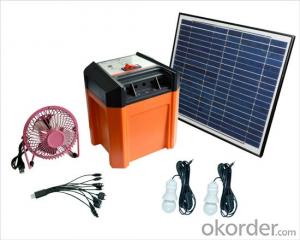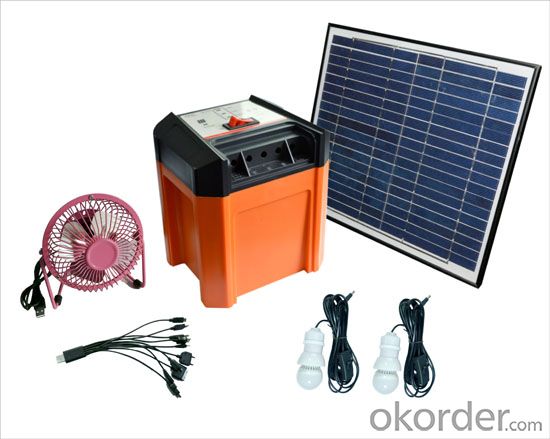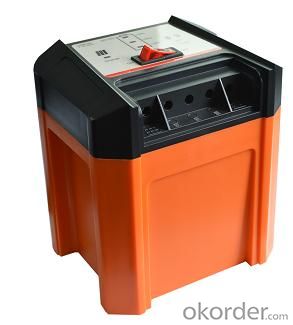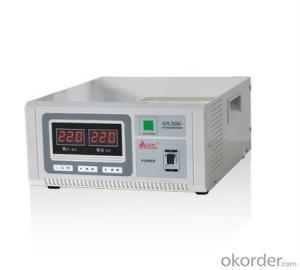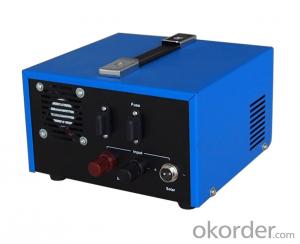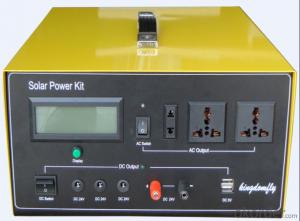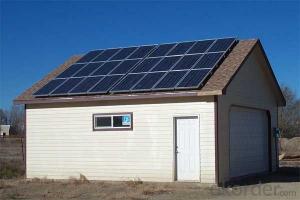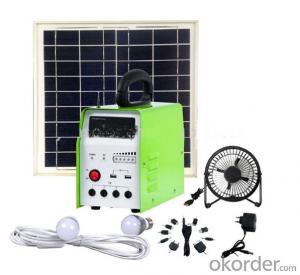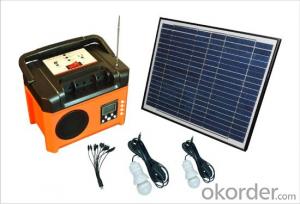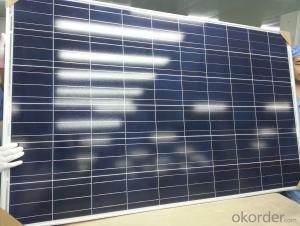Solar Energy Systems Dallas County:Solar Power System with Built-in Battery and USB
- Loading Port:
- Shekou
- Payment Terms:
- TT OR LC
- Min Order Qty:
- 50 unit
- Supply Capability:
- 5000 unit/month
OKorder Service Pledge
OKorder Financial Service
You Might Also Like
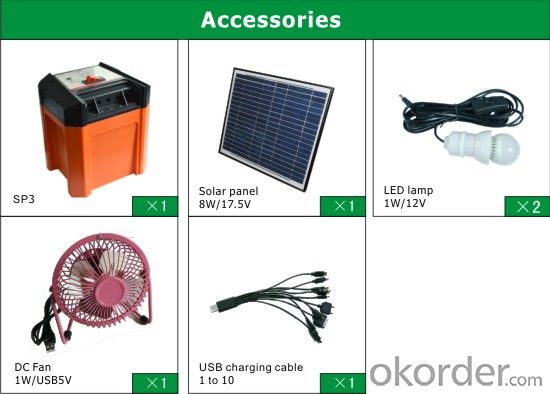
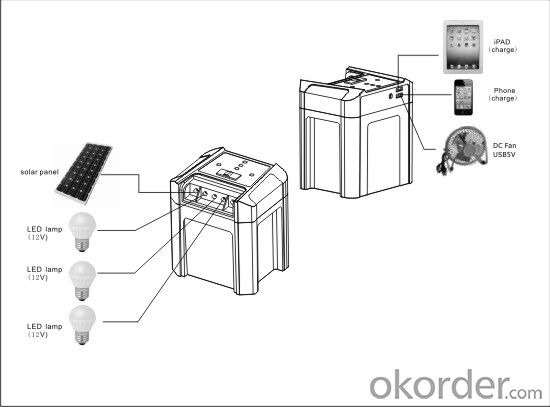
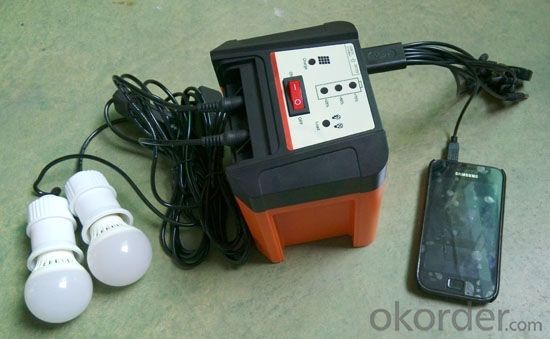
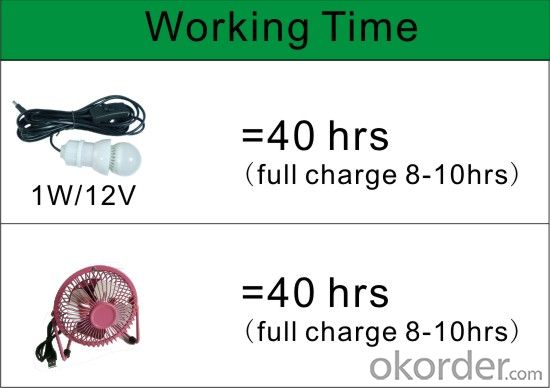
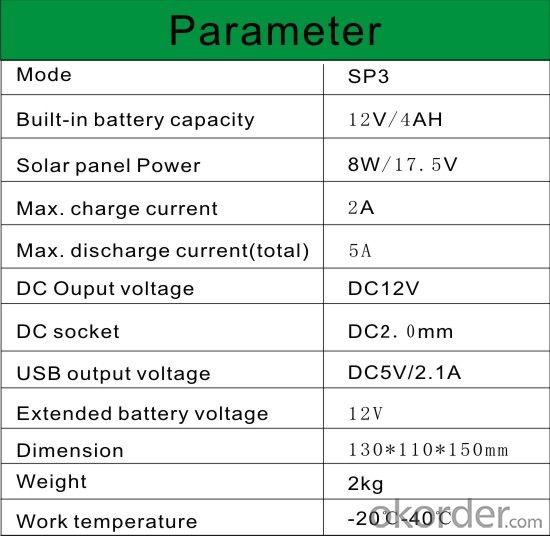
This system designed to provide DC power supply for power lighting,mobile phone charging,run the DC Fan and Radio,etc
Built-in maintenance-free Lead-acid battery
Adopt the latest PWM Control modulation,real time display of battery capacity and load status.
With several output socket,can output voltage DC 12V and DC 5V at the same time.
It can charged by solar panel
Voice warning and together LED indicator shows the battery get low.
Bulit-in battery capacity:12V/4AH
Solar panel power:8W/17.5V
Max.discharge current(total):5A
Max.charge current:2A
DC Output voltage:DC12V
Weight:2KG
Work temperature:-20-40
USB output voltage:DC5V/2.1A
DC socket:DC2.5mm
- Q: How do solar energy systems handle excess power generation?
- Solar energy systems handle excess power generation through a process called net metering, where the excess electricity produced by the system is fed back into the grid. This allows the owner to receive credits for the excess energy, which can be used to offset the electricity consumed during times when the system is not generating enough power, such as during nighttime.
- Q: What is the impact of electromagnetic interference on solar energy system performance?
- Electromagnetic interference can have a negative impact on the performance of solar energy systems. It can disrupt the communication and control signals within the system, leading to reduced efficiency and functionality. Additionally, electromagnetic interference can introduce noise and disturbances in the power output, affecting the overall reliability and stability of the system. Therefore, proper shielding and mitigation techniques need to be implemented to minimize the impact of electromagnetic interference on solar energy system performance.
- Q: Can solar energy systems be used for powering electric vehicle car-sharing programs?
- Solar energy systems have the potential to power electric vehicle car-sharing programs effectively. The utilization of solar panels installed on car-sharing stations or nearby buildings can generate renewable and clean energy. This energy can then be used to charge the electric vehicles in the program. By incorporating solar energy, car-sharing programs can greatly diminish their carbon footprint and reduce their dependence on fossil fuels. Moreover, solar-powered car-sharing initiatives can benefit from reduced operating costs by eliminating the need for costly grid electricity, which is susceptible to price fluctuations. In summary, the integration of solar energy systems into electric vehicle car-sharing programs offers an environmentally friendly and sustainable solution.
- Q: Are there any safety certifications required for solar energy systems?
- Solar energy systems require safety certifications to ensure their safe operation. In most countries, these systems must meet specific safety standards and regulations before installation. These certifications guarantee that the solar panels, inverters, and other components are manufactured and installed in a way that minimizes electrical hazards, fire risks, and other safety concerns. The International Electrotechnical Commission (IEC) 61730 standard is one of the most common safety certifications for solar energy systems. It ensures that the solar panels meet strict safety requirements, including mechanical strength, resistance to environmental factors, and electrical insulation. It also includes tests for fire resistance, which is crucial to prevent potential hazards. Safety certifications are also required for solar inverters, which convert the DC generated by solar panels into the AC used in homes and businesses. The IEC 62109 standard is widely recognized for verifying that inverters meet safety requirements such as electrical insulation, protection against overvoltage and overcurrent, and proper grounding. Moreover, the installation of solar energy systems must comply with local electrical and building codes that often incorporate safety requirements. These codes guarantee correct and safe installation, including proper wiring, grounding, and protection against electrical faults. Adhering to these safety certifications and regulations is essential for solar energy system manufacturers, installers, and users. It ensures the safe and reliable operation of the systems, minimizing the risk of electrical accidents, fires, and other safety hazards. This provides peace of mind to both system owners and the surrounding community.
- Q: Can a solar energy system be installed in areas with extreme weather conditions?
- Indeed, solar energy systems have the capability of being installed in regions that experience severe weather conditions. These systems are specifically constructed to endure a broad spectrum of weather phenomena, including extreme cold, heat, wind, rain, and snow. In fact, solar panels are frequently utilized in diverse areas with intense weather conditions, such as deserts, arctic regions, and coastal zones. To guarantee the sturdiness and effectiveness of the system, solar panels are constructed using top-notch materials that possess the ability to withstand adverse weather conditions. They are designed to be resistant to impact and undergo rigorous testing to ensure they can endure hail, strong winds, and heavy snow loads. Furthermore, the frames and mounting systems employed for solar panels are engineered to provide stability and protection against extreme weather events. Even in frigid weather conditions, solar energy systems can still function efficiently, although their performance may be slightly affected by the lower temperatures. Solar panels are specifically designed to absorb sunlight, enabling them to generate electricity even under low-light circumstances. In snowy areas, solar panels are typically installed at an angle to facilitate the shedding of snow and prevent accumulation that could reduce their efficiency. In regions with scorching heat, solar energy systems can still operate effectively, albeit with a slight reduction in panel efficiency due to elevated temperatures. Nevertheless, contemporary solar panels are equipped with heat dissipation features to minimize any performance losses caused by high temperatures. In summary, solar energy systems possess remarkable adaptability and can be successfully installed in areas that experience extreme weather conditions. They are designed to withstand a wide range of weather elements, ensuring the generation of clean and renewable energy persists even in challenging environments.
- Q: Can solar energy systems generate power at night?
- No, solar energy systems cannot generate power at night because they rely on sunlight to produce electricity.
- Q: Can solar energy systems be used in conjunction with backup generators?
- Yes, solar energy systems can be used in conjunction with backup generators. This combination allows for a reliable and uninterrupted power supply, as solar panels can generate electricity during the day while excess energy can be stored in batteries or fed back into the grid. Backup generators can then be used as a secondary power source during periods of low solar generation or in case of emergencies.
- Q: What is the role of power optimizers in solar energy systems?
- Power optimizers play a crucial role in solar energy systems by maximizing the efficiency and output of each individual solar panel. They help to mitigate the impact of shading, temperature variations, and panel mismatch, ensuring the system operates at its highest level of performance. Power optimizers also provide real-time monitoring and fault detection, enabling proactive maintenance and enhancing the overall reliability of the solar energy system.
- Q: What are the benefits of using solar energy?
- There are several benefits of using solar energy. Firstly, it is a renewable and abundant source of energy, meaning it will never run out. Additionally, solar energy is clean and does not produce harmful greenhouse gas emissions, making it environmentally friendly. Moreover, using solar energy can help reduce electricity bills as it allows homeowners and businesses to generate their own power. Lastly, solar panels require minimal maintenance and have a long lifespan, offering a cost-effective energy solution in the long term.
- Q: How much do solar energy systems cost?
- The cost of solar energy systems can vary significantly depending on various factors such as the size of the system, location, quality of equipment, and installation costs. On average, residential solar energy systems can range from $10,000 to $30,000, but it's important to get a personalized quote from a reputable solar provider to get an accurate cost estimate for your specific needs.
Send your message to us
Solar Energy Systems Dallas County:Solar Power System with Built-in Battery and USB
- Loading Port:
- Shekou
- Payment Terms:
- TT OR LC
- Min Order Qty:
- 50 unit
- Supply Capability:
- 5000 unit/month
OKorder Service Pledge
OKorder Financial Service
Similar products
Hot products
Hot Searches
Related keywords
